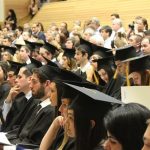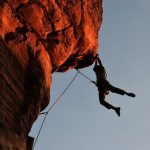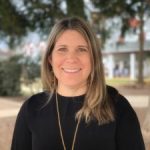As a district re-opens, one middle schooler returned to school and another remained home
Get important education news and analysis delivered straight to your inbox
BROCKTON, Mass. — It was starting to feel like a normal seventh grade lunch at West Middle School. After several days of eerily quiet cafeteria reunions, the din from the cafeteria could be heard far down the hall. The plexiglass dividers that sectioned off the lunch tables into four socially distanced stations no longer intimidated the kids; they shouted across them — or chatted happily together in one of the quarters when teachers turned their backs.
Twelve-year-old Isabella Rogers sat at one of the tables, grateful for the noise (“I like playing the drums and I like being loud”) and happy to be reunited with two members of her “best friend group” after nearly a year of pandemic-induced remote learning (the fourth group member had chosen to stay remote, for now). As lunch wound down, their conversation — which ping-ponged between creative uses for ketchup packets and speculation about what songs they would play in band — had Isabella so preoccupied that she didn’t immediately notice another nearby friend.
The girl sat with her hood up, physically shaking, her eyes watering. Her hand rhythmically tapped the table, fast and faster. Accustomed to solitude, the commotion had brought on an anxiety attack. Pulling away from her best friend group, Isabella bent in for a non-socially distanced huddle. (Ever vigilant over friends’ well-being, she felt annoyed with herself for not noticing the girl’s distress earlier.)
It was a small reminder of how fragile and halting recovery can be for the thousands of children who returned to school buildings in this diverse city over the past few weeks. A combination of federal and state pressure, coupled with rising vaccination rates and falling Covid rates, spurred a sea of re-openings this spring. At the end of March, more than half of Black, Latino and Asian eighth graders had attended fully remote school, according to the latest federal data, more than twice the share of white students. But as thousands of schools enrolling mostly students of color reopened their doors, it’s likely the racial gaps decreased significantly in April — although the data won’t be compiled for several weeks.
Here, and in countless other communities, many kids, parents and educators have faced heart-rending choices over the last month: teachers who encourage kids to be kids risk an end to social distancing; families who send a child back full time for desperately needed academic supports may increase the family’s chance of contracting Covid; students who stay remote risk becoming a virtual afterthought in a newly nonvirtual classroom.
Related: Schooling has changed forever. Here’s what will stay when things go back to normal
The low vaccination rate in Brockton, coupled with the community’s relentlessly high Covid rates, has amplified the stakes here. Since the beginning of the pandemic, the city of 95,000 has reported about 14,000 cases; the positivity rate from late April to the first week of May was around 5 percent. Brockton, like many communities, opted for a gradual return to schools. After a year of purely remote learning, elementary and middle school students were offered one day a week of in-person instruction in March; that was followed by two days a week the first half of April. Late last month, they could return full time.
The large number of students returning to in-person classes — at West Middle about 76 percent of students are back — is a testament to families’ reliance on the city’s schools, and their trust in the public school system. (In New York City, by contrast, slightly less than 40 percent of students opted for in-person as of April.)
Carlton Campbell, West’s principal, has deep community roots that help engender trust: A Brockton native and graduate of its public school system, he has personal ties to scores of his students; he went to church with one student’s daddy, played on the Brockton High football team with another’s uncle, and knows an eighth grader’s mama from when she attended college with his sister. Many students are familiar with his personal story (including how he caught Covid in December from a colleague, passed it on to his entire family, and battled a serious case for several days).
Trust in West Middle all too often exceeds the confidence Brockton public school families feel in the doctors and government officials who’ve been exhorting them to get vaccinated all spring: As of early May, about 40 percent of Brockton residents had received at least one shot, putting the city’s rate closer to that of a majority-Black community like New Orleans than to the rest of Massachusetts, where about 60 percent had one or both shots.
At West, 60 percent of students are African American, 20 percent are white, and 12 percent are Latino. In Brockton itself, Black residents comprise nearly half of the population. The median household income of $58,000 falls about $20,000 below the state median.
Since the beginning of the pandemic, Brockton, Massachusetts, a city of about 95,000, reported more than 13,800 Covid cases; the positivity rate from late April to the first week of May was around 5 percent.
“I know in the Black community it’s going to be awhile until people feel comfortable,” said Campbell, who plans to get his shots later this spring. News that a small number of Johnson & Johnson vaccine recipients developed blood clots only heightened the anxiety, he said. “One of the big issues is that we don’t believe everything the government and doctors tell us — we’ve learned our lesson throughout history.”
Despite the continued risk, Campbell witnessed a steady drop in social inhibition among the kids once his school opened: They increasingly brushed up against each other in hallways; and teachers — who were alternately pleased and perturbed by the unusual quiet – no longer had to encourage students to put down their phones and talk to each other.
“The honeymoon period is over,” Campbell said, days before the full return. He had mixed feelings about that.
For West’s families, the sometimes agonizing calculus over whether to return often hinged on two factors: health concerns and how well — or dismally — remote learning had gone.
Isabella is blunt in her assessment of remote learning: “I hated it,” she said. She gets distracted easily, she explained, and without the accountability provided by teachers it was far too easy for her to slip back into bed and zone out during classes. (Brockton schools required students to turn cameras on at the very beginning and end of classes, but many students say they opted out during the middle of class.)
The only way that seventh grade science teacher Robert Connelly could glimpse Isabella’s social spark was through online chats where she regularly offered to help out classmates. “I knew something was there,” he said.
Related: Schools use art to help kids through trauma
To a degree unusual even for a 12-year-old, Isabella’s life revolves around the routines and relationships of school; without them she felt unmoored. “During the quarantine, she had no desire to go outside,” said her mother, Chandra Rogers. She preferred to “stay in pajamas all day and do nothing.” Rogers added that Isabella’s grades “suffered tremendously.” The girl’s 21-year-old brother, Dylan, had to coax her through some schoolwork, so they could practice basketball, a favorite activity.
It wasn’t hard for Isabella’s mother to decide to send her back. “She’s my social butterfly,” Rogers said. “I knew that even at 12 years old she would be responsible, and wash hands and use her mask.”
For other families, the calculus was harder. Mercedes Powell, the mother of two teenagers, knew that 13-year-old Oswald, an eighth grader at West, and his older sister were missing out on important socialization. “My daughter hasn’t spoken to [friends] in over a year,” she said.
Yet there were many arguments in favor of keeping Oswald, especially, at home. He prefers studying online; there are fewer distractions and he can focus better. There aren’t, he said, “teachers yelling at me when I’m trying to do my work … or teachers calling on me when I’m not raising my hand.” A tutor hired by his mother, Mercedes Powell, helped fill in any gaps.
Powell has not been vaccinated yet, one of a dwindling number of holdouts among her co-workers at the Boston Medical Center, where she is a cash services manager. She works mostly remotely, but has to go in once a week to submit hard copies of reports for signatures. She leaves at 3 a.m. on Fridays so that she can be home by 5 a.m. to help her two children get ready for the school day. (Despite their remote schedule, she wants to keep them accustomed to rising early for school.)
“Everything was going through my head … I was nervous. I was scared. I was worried. Personally, I like school so I was annoyed. I didn’t want to go home.”
Isabella Rogers, a seventh grade student, after being sent home when a classmate tested positive for Covid
The most important factor in her decision: Oswald has sickle cell disease, a condition that makes him particularly vulnerable to Covid. A pediatrician cautioned Powell against sending Oswald back to school, but gave the okay for his older sister, with significant safety precautions. In the end, Powell decided to keep both her children home through the end of the school year. She had heard about Campbell’s family’s ordeal with Covid, and knew that the virus was no joke. Despite studies showing there isn’t substantial transmission risk at most schools, the risk at home was even less.
“He’s not vaccinated. I’m not vaccinated, and with this disease that came out and hit everyone, I can’t put my son in that vulnerable state … I would be devastated if anything happened.”
On April 26, the first day that West reopened full time, students drowsed in class and lockers were fastened shut. Yet, other staples of middle school life persisted, including handwritten bathroom passes — and students who defied their time limits to roam the halls. In-person attendance was healthy, with about 540 of the school’s students showing up that day.
For her part, Isabella had no problem staying awake.
Back in person, she volunteered to answer nearly every question — and then some, talking even when she was supposed to be quiet. With the resumption of in-person learning, her grades have risen from mostly Ds and Fs to mostly As and Bs.
Related: California’s COVID-19 recovery plan seeks to improve higher education equity
Yet there is still a lot of catching up to do, in subjects ranging from math to band—Isabella’s favorite.
The last Tuesday in April, most of West’s band got together again, one of its first gatherings in over a year. It was an odd sight, with the brass instrument players — mostly wielding trombones and tubas— spaced out a regulation 10 feet on the stage, along with the saxophonists; all players wore special masks with small slits that provided an opening to blow. The rest of the woodwind players — flutists and clarinetists — spread out in the spacious stadium seating. The percussionists, Isabella included, stood off to the side on the stage.
Although excited to be back, there was a flatness to their sound. Band teacher Andrew Fantucchio cautioned that without a lot of progress, they wouldn’t be ready to play “Blaze” — a challenging song that’s beloved by the students — for the outdoor concert in early June.
“A lot of them are relieved to be back,” he said. “You could see the fatigue that went with remote learning.” But just making noise isn’t enough: They need to do it in a self-possessed and collaborative way. It’s a “struggle getting them to be confident after they’ve been away from people so long,” he said. “They are afraid to express themselves. That’s the challenge — building their confidence back up.”
Off campus, William Wells, who oversees the school’s mentoring initiatives, had his own challenges that first week back full time. He paid more than a few home visits to students he thought might need an extra hand — or nudge. They were a mix of remote learners and no shows. The first visit was to Oswald’s house. The eighth grader appeared at the front door in his slippers, pleased to report his honor roll grades but a bit anxious about the mass return of students. “It’s kind of different with nearly every single kid in school,” he told Wells. Some instructors “might forget the teacher has to work with us, too.”
Mercedes Powell was extra vigilant that week to ensure that Oswald’s teachers didn’t neglect him. In one class, a teacher marked Oswald absent after failing to notice the small circle on her computer screen with “OP” inside (for Oswald Powell). “Ozzy was waiting for him to call on him,” his mother said.
About 540 students — roughly 80 percent of those enrolled — showed up for in-person classes on April 26, the first day that West Middle School in Brockton, Massachusetts reopened full time.
And in his first period class one day, Oswald tried repeatedly to answer a question. But no one on the other end could hear him because they had the speakers turned off. “I kept saying the right answer,” said Oswald. “Sometimes they hear me. Sometimes they don’t.”
Powell is not shy about calling the school to make sure her son is getting what he needs. And she sympathizes with the teachers who are “trying to make sure everyone has a piece of their time.” Spending school days monitoring her children at home has made her a more active participant in their education. “I look at their grades every single day,” she said. “I didn’t before the pandemic”
Yet she worries about kids whose parents don’t have the time or wherewithal for eagle-eyed monitoring — not to mention the money for a tutor to fill in gaps. She hopes that at some point the pandemic will abate enough so that she will feel comfortable sending Oswald and his sister back to school buildings, not only to benefit from socialization, but also to get more attention from teachers in core subjects like English and math. “The work is not getting any easier,” she said.
Related: The pandemic’s remote learning legacy: A lot worth keeping
Oswald, however, fears that back inside a building, distractions will drag down his grades once again. “For me, staying remote is about health and education,” he said. “For my mom it’s a little about education but mainly health.”
There will likely be a small number of families who will continue to prefer remote next school year, said Brockton schools superintendent Michael Thomas. As a result, the district plans to open a small virtual-only school, with its own designated teachers. “I want 100 percent of the kids back,” he said. “But we will have a remote school as an option.”
As much as Oswald wanted to stay away from school, Isabella yearned to stay there. Ever social, she kept an eye out even for those who weren’t — physically — there. In a Spanish class one day, Isabella heard a remote learner’s calls for assistance while the teacher was preoccupied. “Someone there wants you,” she said, motioning to the computer in the back of the room.
Isabella is sensitive to any change in her school routine or friendship group. Every day, she insists on walking one of her best friends to lunch. And it troubles her that one member of the group has stayed remote. The three boys and Isabella bonded almost instantly at the start of sixth grade; Isabella says she won’t feel totally at ease at school until they are all there.
On her third day back full time, Isabella settled in with her best-friend group for a school lunch of pizza or chicken sandwich, carrots, oranges and milk.
“I’ll pay you a dollar to drink your ketchup with nothing else,” a boy told Isabella.
“Hell no,” Isabella replied. Unperturbed, the boy evenly spread the contents of his own ketchup packet across a pizza slice.
The conversation veered off to what music they might play at band later that day, and the number of minutes left in lunch. But it always came back to ketchup. When her best friend, Philippe, accepted a dare to eat his carrots coated in the condiment, the whole table erupted.
“He’s not vaccinated. I’m not vaccinated, and with this disease that came out and hit everyone, I can’t put my son in that vulnerable state … I would be devastated if anything happened.”
Brockton parent Mercedes Powell on why she is not sending her son back to in-person classes
Isabella sat doubled over, laughing, slapping the table with her hand.
“Are you crying?” her friend asked.
“My stomach hurts,” she said.
Pleased with the results, Philippe smiled broadly — providing a rare, maskless glimpse of a shiny set of braces.
Principal Campbell said keeping the kids regulation-distance apart had been tougher than he envisioned, especially at lunch. “Middle schoolers don’t follow guidelines. They want to be with their friends,” he said. “And they think they are superhuman.”
“We are issuing constant reminders about the seriousness of the virus.”
Between late September and the end of April, 62 Brockton public school students and 102 staff members tested positive for the virus (all of them spent time in the schools although they did not necessarily get infected there), according to state data. In the first week of May, 24 students and five staff tested positive — the highest reported district total in the state that week.
A district spokeswoman said they are “closely monitoring the number of cases” among students. Whenever a new case is identified, she said, the school sends a text message notification to all families.
“A lot of them are relieved to be back … You could see the fatigue that went with remote learning.”
Andrew Fantucchio, band teacher at West Middle School in Brockton, Massachusetts
During Isabella’s third period on her first Friday back full time, the school nurse unexpectedly summoned her to the office. The news, Isabella knew, could not be good. Once there, she learned that she’d been in “close contact” — within six feet for at least 15 minutes — of a classmate who tested positive for Covid. (Classroom desks are spaced three feet apart.)
She would have to leave campus immediately, and stay away until at least eight days after exposure — the following Wednesday. Without a negative test, the quarantine would be longer.
“Everything was going through my head,” she said. “I was nervous. I was scared. I was worried. Personally, I like school so I was annoyed. I didn’t want to go home.”
Isabella took her Covid test on Monday. The next two days felt like a painful form of deja vu: The boredom. The isolation. Once again, she could barely focus on schoolwork at all. She killed some of the time by creating a running list of other who kids were newly remote, and who might have also been exposed. “I’m at 13. And that’s just kids I know.”
By late Tuesday, Isabella had her negative test results in hand and the eight-day period was drawing to a close. “That was only four days,” she said, back at school on Wednesday, “and it felt like forever.” (Campbell said all of the exposed students ultimately tested negative.)
Even with school reopened full-time, Isabella was beginning to realize that she couldn’t count on everyone being in their usual spots at the usual times. The next week, several bandmates — “close contacts” of new positive cases — quarantined at home. The auditorium felt emptier than ever, the percussion section, muted and small. Yet Isabella, determined to keep the still-recovering band moving forward, continued to bang away on the drums with all her heart.
This story about remote learning was produced by The Hechinger Report, a nonprofit, independent news organization focused on inequality and innovation in education. Sign up for Hechinger’s newsletter.
Published at Tue, 18 May 2021 11:00:00 +0000
Article source: https://hechingerreport.org/as-a-district-re-opens-one-middle-schooler-returned-to-school-and-another-remained-home/



